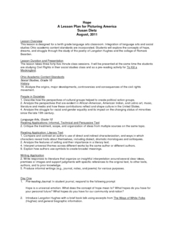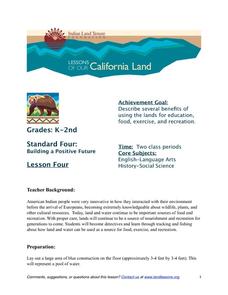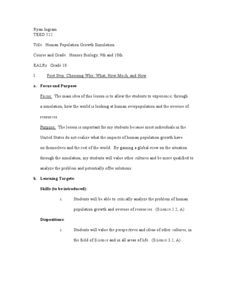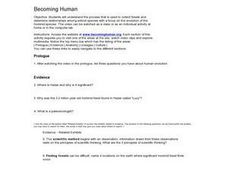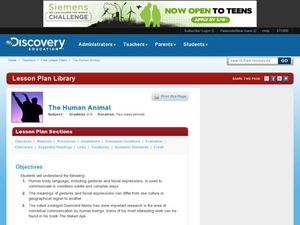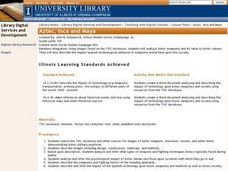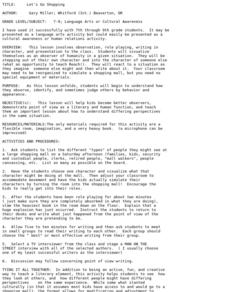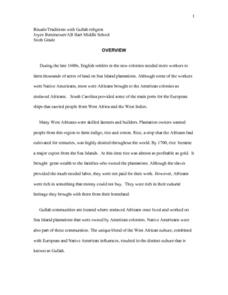Curated OER
Picturing America: Images and Words of Hope from Romare Bearden and Langston Hughes
A carefully crafted three-day lesson integrates poetry and visual art. By analyzing and comparing Langston Hughes' poem "Mother and Son" and Romare Bearden's collage "The Dove," readers explore the theme of hope. The lesson activates...
Curated OER
Is It Ethical to Eat Meat?
Have your class join a blog about whether or not eating meat is good for you. They'll read several passages regarding meat processing and consumption, then they post what they think. There are six critical-thinking prompts to help them...
Indian Land Tenure Foundation
Gifts from Land and Water
With a series of fun hands-on simulations, young children can learn about conservation and natural resources. Your learners become land detectives, discussing and investigating the gifts that the land and water provide them. They then...
Curated OER
Human Population Growth Simulation
Students simulate the growth of human population. In this biology lesson, students explore different perspectives on this issue. They write a reflection at the end of the activity.
Curated OER
Becoming Human
In this evolution worksheet, students access a specific website and then answer questions about human evolution based on what they discovered at the website. This worksheet has 19 short answer questions and 3 essay questions.
Curated OER
Judges in the Classroom
Learners examine the classification categories of rights including liberty, security, cultural, and group rights. They identify and analyze the various similarities and differences among five countries and their constitutions.
Curated OER
Lesson Plan on Tolerance
Students, through discussion, internet and video resources, study the history of Northern Ireland and the religious segregation between Catholics and Protestants. They evaluate the current political situation and predict what the future...
Curated OER
The Human Animal
Students explore non-verbal communication. In this animal communication lesson, students study body language and other forms of non-verbal communication. Students write a summary of their findings to discuss with the class. This lesson...
Curated OER
Rostislav & Julianna: A Modern-Day Interpretation of Romeo and Juliet
Students author and film their own adaptations of Romeo and Juliet by William Shakespeare. In this multimedia skills lesson, students script a play that pits an Orthodox Christian family against a Muslim family. Students use GarageBand...
Curated OER
Japan
Students locate Japan's absolute and relative location on a globe and various maps. They describe Japan's various regions and islands and their system of education, customs and religion. They assess Japan's impact on our society.
Curated OER
Aztec, Inca, and Maya
Seventh graders use images of Aztec weaponry to analyze its' value. They create a Word Document with the information.
Curated OER
"Virtual" Model United Nations Day
Students identify and analyze that Global Interdependence and Internationalism have become major themes in human activity in the areas of population, environment, the world economy, and the United Nations.
Students identify the...
Curated OER
Global Issues
Pupils explore the ways that local, national, and global events are interconnected. They identify current issues at a local and global level, identify organizations that seek to improve conditions in other countries, and examine the role...
Curated OER
Anne Frank: Rescuers
Students discuss heroic behavior of individuals from the Holocaust. They examine early civilizations and their contributions to the foundations of human culture. They
recognize that heroic behavior (just like discrimination) is done...
Facing History and Ourselves
How Do Rules and Traditions Shape Communities?
Sixth graders explore the concepts of laws and customs in a community, examining the reasoning behind rules. Then then collaborate to write their own classroom code of conduct.
Curated OER
In the Future we will all be Mixed Bloods and Mestizoes
Students examine the concept of origin and ethnicity. In this ethnic studies instructional activity, students engage in a variety of interdisciplinary activities including posters, and discussions to better understand our past and future.
Curated OER
Gyotaku Lesson Plan
Learners study the Japanese art of fish painting called Gyotaku while examining the lifestyle of Japanese fishermen at the end of the Edo period. They make a Gyotaku fish print and write a haiku poem using the proper number of syllables...
Curated OER
Let's Go Shopping
Students explore how to become better observers, demonstrate point of view as a literary and human function, and learn an important lesson about how to explain differing perspectives in the same situation.
Curated OER
Back to Basics
Students examine the unique and diverse historical artifacts that people have designed to fulfill their everyday needs in extraordinary ways. They identify ways humans have used design throughout history to enhance the ways they meet...
Curated OER
Changing Borders
Middle schoolers explain that the boundaries between countries are not permanent, then analyze current events and stories as examples of cooperation and conflict. They describe a place using physical and human characteristics.
Curated OER
Pizza and the Economy
Young scholars become aware of the history behind pizza and how it was adapted to the economic and geographic conditions of the United States. They have a basic understanding of the concepts of supply and demand.
Curated OER
Pete And Repeat
Students draw a picture of a person from popular culture, then "clone" it using printing techniques in this Art lesson that tackles the questions surrounding cloning, DNA, and current scientific techniques. An emphasis is placed on the...
Curated OER
Why Kosovo? Why Now?
Students explain the establishment of the modern state of Yugoslavia and the breakup of the country. They examine the human characteristics of the region - ethnic groups, languages, and religions.
Curated OER
Rituals/traditions with Gullah religion
Sixth graders discuss some of the earliest people who lived in each region in order to comprehend how humans interacted with the environmental conditions at that time. They make connections to present-day regions including...
